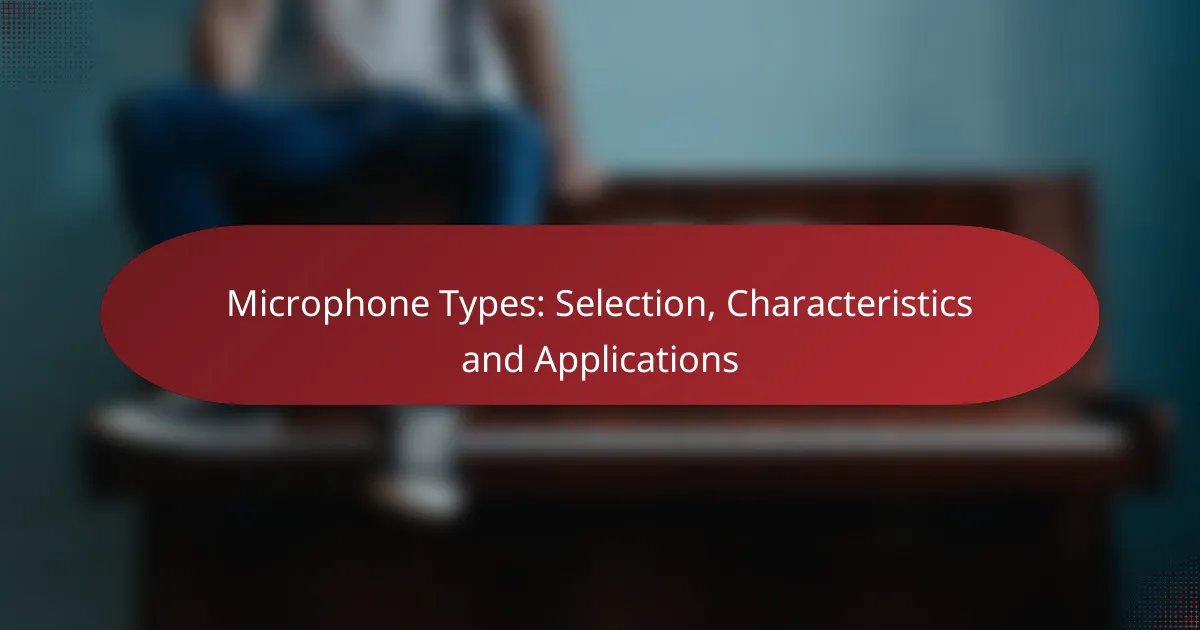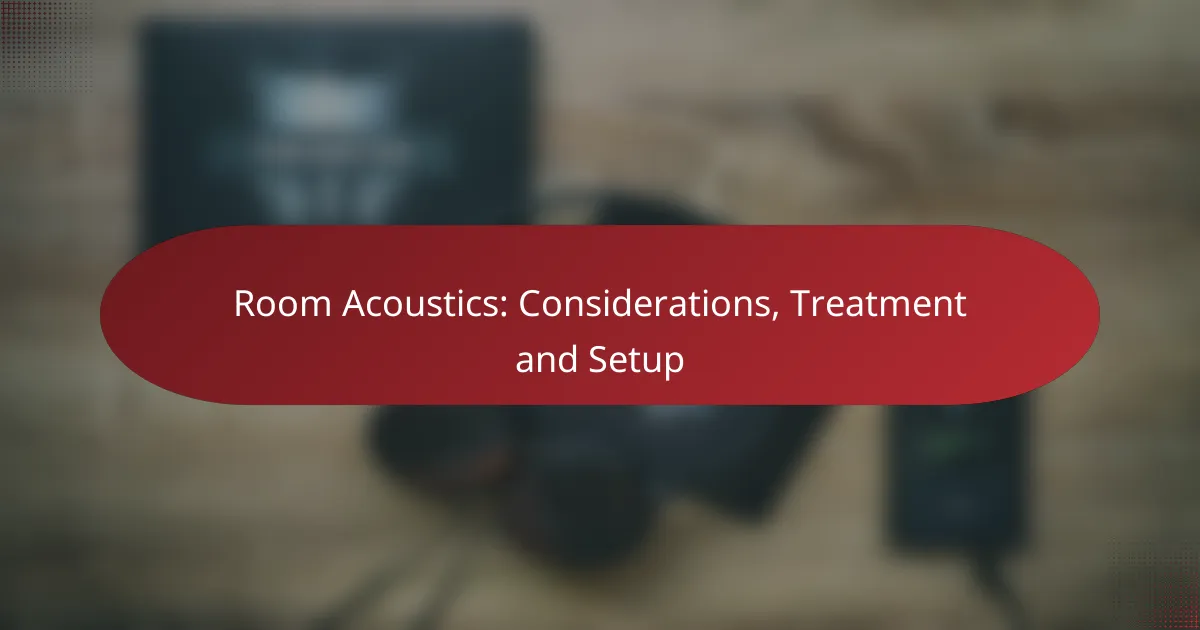Microphones come in various types, each designed for specific recording needs and environments. Understanding the characteristics of condenser, dynamic, ribbon, USB, and lavalier microphones can significantly enhance your audio quality, whether for home recording, podcasting, or live performances. By selecting the right microphone, you can ensure that your recordings are clear, professional, and tailored to your unique requirements.

What are the best microphone types for home recording?
The best microphone types for home recording include condenser, dynamic, ribbon, USB, and lavalier microphones. Each type has unique characteristics that make it suitable for different recording scenarios, so understanding their strengths can help you choose the right one for your needs.
Condenser microphones
Condenser microphones are highly sensitive and ideal for capturing vocals and acoustic instruments in detail. They operate using a diaphragm that vibrates in response to sound waves, requiring phantom power to function. These microphones excel in studio settings where clarity and nuance are essential.
When selecting a condenser microphone, consider the polar pattern, which affects how sound is captured from different directions. Cardioid patterns are popular for vocals, while omnidirectional types can be useful for capturing ambient sounds.
Dynamical microphones
Dynamical microphones are robust and versatile, making them suitable for both studio and live environments. They use a moving coil to convert sound into an electrical signal, which allows them to handle high sound pressure levels without distortion. This durability makes them a favorite for recording loud instruments like drums and electric guitars.
For home recording, dynamic microphones are often more affordable and do not require external power. They are less sensitive than condensers, which can be advantageous in untreated spaces where background noise is a concern.
Ribbon microphones
Ribbon microphones offer a warm, natural sound and are particularly effective for recording vocals and brass instruments. They utilize a thin metal ribbon suspended in a magnetic field to capture sound, resulting in a smooth frequency response. However, they are more fragile than other types and require careful handling.
These microphones are often used in professional studios for their unique tonal qualities. If you choose a ribbon microphone, ensure you have a preamp that can provide sufficient gain, as they typically have lower output levels compared to dynamic and condenser microphones.
USB microphones
USB microphones are convenient for home recording, as they connect directly to computers without the need for additional audio interfaces. They are user-friendly and often come with built-in preamps, making them ideal for beginners and podcasters.
When selecting a USB microphone, look for models with good audio quality and features like adjustable gain and headphone monitoring. They are available in various styles, including dynamic and condenser, allowing you to choose one that fits your recording needs.
Lavalier microphones
Lavalier microphones, or lapel mics, are small and discreet, making them perfect for interviews, presentations, and video production. They can be clipped onto clothing, providing hands-free operation while capturing clear audio from the speaker.
These microphones can be wired or wireless, with wireless options offering more flexibility. When using a lavalier microphone, pay attention to placement and background noise, as they can pick up sounds from the environment if not positioned correctly.

How to choose the right microphone for podcasting?
Choosing the right microphone for podcasting involves considering audio quality, connectivity options, portability, and software compatibility. Each factor plays a crucial role in ensuring your recordings are clear and professional, enhancing the overall listening experience.
Consider audio quality
Audio quality is paramount in podcasting, as it directly affects listener engagement. Look for microphones that offer a frequency response suitable for voice, typically between 20 Hz and 20 kHz, and consider options with a cardioid pickup pattern to minimize background noise.
Dynamic microphones are often preferred for their durability and ability to handle high sound pressure levels, while condenser microphones provide a broader frequency range and sensitivity. Testing different models can help you find the best fit for your voice and recording environment.
Evaluate connectivity options
Connectivity options are essential for seamless integration with your recording setup. USB microphones are user-friendly and ideal for beginners, as they plug directly into a computer without the need for additional equipment.
XLR microphones, on the other hand, offer superior audio quality and flexibility but require an audio interface or mixer. Assess your current equipment and future needs to determine which connection type aligns with your podcasting goals.
Assess portability
Portability is a key consideration if you plan to record in various locations. Lightweight and compact microphones are easier to transport, making them suitable for on-the-go recording sessions.
Consider whether you need a microphone that can withstand travel and outdoor conditions. Some models come with protective cases or are designed for durability, which can be beneficial for frequent travelers.
Check compatibility with software
Ensure that your chosen microphone is compatible with your recording software. Most USB microphones work with popular digital audio workstations (DAWs) like Audacity or GarageBand, but it’s wise to verify compatibility beforehand.
If using an XLR microphone, check that your audio interface supports the necessary drivers and formats. This step can prevent technical issues during recording and streamline your workflow.

What are the characteristics of condenser microphones?
Condenser microphones are known for their high sensitivity and ability to capture a broad range of frequencies, making them ideal for studio recording and live performances. They operate using a capacitor that converts sound waves into electrical signals, which allows them to deliver detailed audio quality.
High sensitivity
Condenser microphones exhibit high sensitivity, meaning they can pick up quiet sounds and subtle nuances in audio. This characteristic makes them suitable for applications like vocal recordings and acoustic instruments, where detail is crucial.
However, their sensitivity can also be a drawback in noisy environments, as they may pick up unwanted background noise. When using condenser mics, consider the recording environment and opt for soundproofing or directional models to mitigate this issue.
Wide frequency response
These microphones typically have a wide frequency response, often ranging from around 20 Hz to 20 kHz, which covers the full spectrum of human hearing. This broad range allows them to capture both low bass tones and high treble sounds effectively.
The wide frequency response is particularly beneficial for recording vocals and instruments, as it ensures that the full tonal quality is preserved. When selecting a condenser microphone, check the frequency response specifications to ensure it meets your recording needs.
Requires phantom power
Condenser microphones require phantom power, usually supplied by an audio interface or mixer, to operate. This power is essential for charging the microphone’s internal capacitor, enabling it to function properly.
When setting up a condenser mic, ensure that your audio equipment can provide the necessary phantom power, typically 48 volts. If you’re using a device that lacks this feature, consider alternative microphones or invest in an external phantom power supply.

What are the applications of dynamic microphones?
Dynamic microphones are widely used in various settings due to their durability and ability to handle high sound pressure levels. They excel in live performances, instrument recording, and broadcasting, making them a versatile choice for audio professionals.
Live performances
Dynamic microphones are a staple in live performances, particularly for vocals and instruments. Their robust construction allows them to withstand the rigors of touring and stage use, while their ability to reject background noise ensures clear sound capture in loud environments.
Common choices for live vocals include the Shure SM58 and the Sennheiser e835, both known for their reliability and sound quality. When selecting a dynamic microphone for live use, consider factors such as feedback rejection and handling noise.
Recording instruments
In the studio, dynamic microphones are often used to record instruments like drums, electric guitars, and brass. Their ability to handle high sound levels without distortion makes them ideal for capturing the energy of loud instruments.
Popular models for instrument recording include the Shure SM57 and the Electro-Voice RE20. When using dynamic microphones for instruments, position them close to the sound source to achieve the best tonal balance and clarity.
Broadcasting
Dynamic microphones are frequently employed in broadcasting due to their durability and ability to minimize background noise. They are particularly effective in environments where ambient sound can interfere with audio quality.
Models such as the Shure SM7B are favored in radio and podcasting for their rich sound and versatility. When choosing a dynamic microphone for broadcasting, consider the microphone’s frequency response and how it complements the speaker’s voice for optimal clarity.

What factors influence microphone pricing?
Microphone pricing is influenced by several key factors including brand reputation, build quality, and specific features. Higher-end microphones typically offer better sound fidelity and durability, which can significantly affect their cost.
Brand reputation
The brand of a microphone plays a crucial role in its pricing. Established brands with a history of quality and reliability often command higher prices due to consumer trust and perceived value. For instance, brands like Shure and Neumann are known for their premium products, which can range from a few hundred to several thousand dollars.
When selecting a microphone, consider the brand’s reputation in your specific application, whether it’s for studio recording, live performance, or broadcasting. A reputable brand may offer better customer support and warranty options, adding to the overall value.
Build quality
Build quality directly impacts a microphone’s durability and performance, influencing its price. Microphones made with high-quality materials, such as metal casings and robust internal components, tend to be more expensive but provide better longevity and reliability. For example, a well-constructed dynamic microphone can withstand the rigors of live performances, while a cheaper model may not.
When assessing build quality, look for features like shock mounts, windshields, and weather resistance, especially if you plan to use the microphone in challenging environments. Investing in a microphone with superior build quality can save you money in the long run by reducing the need for replacements or repairs.










